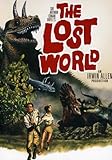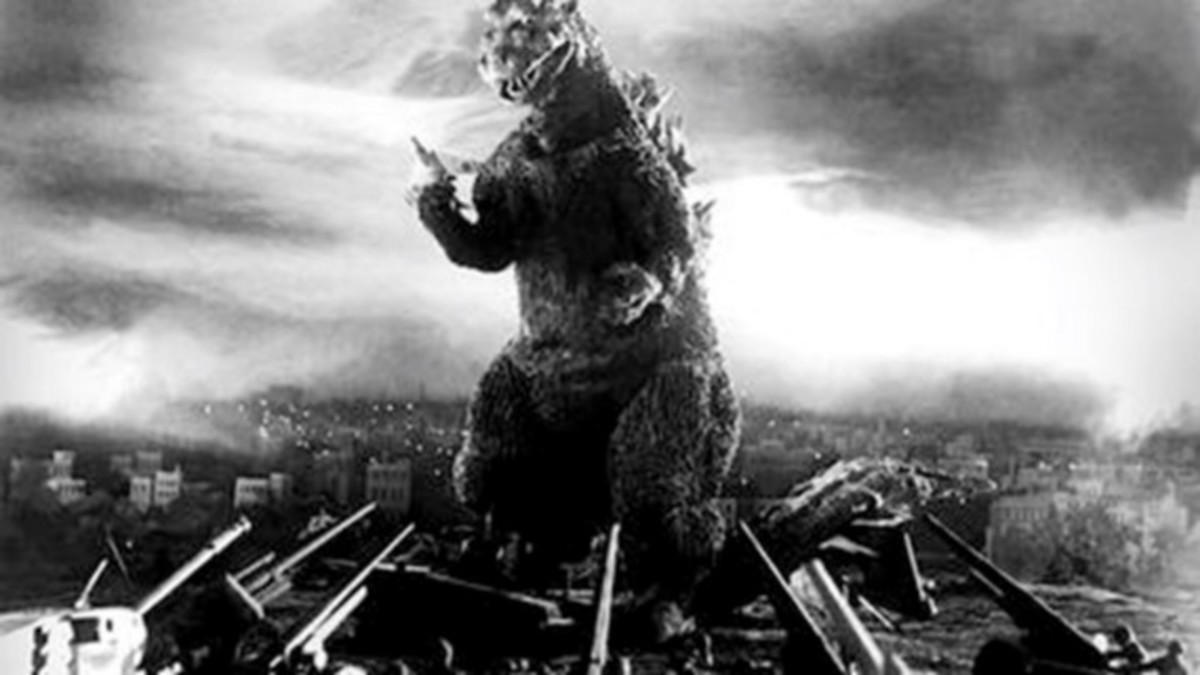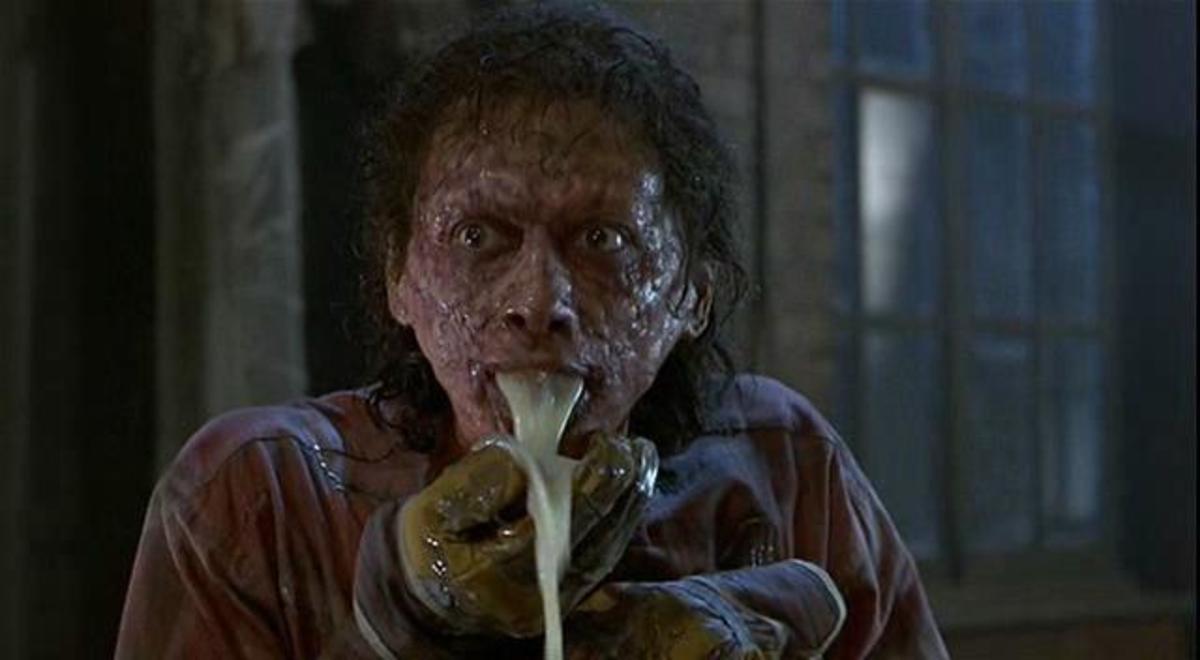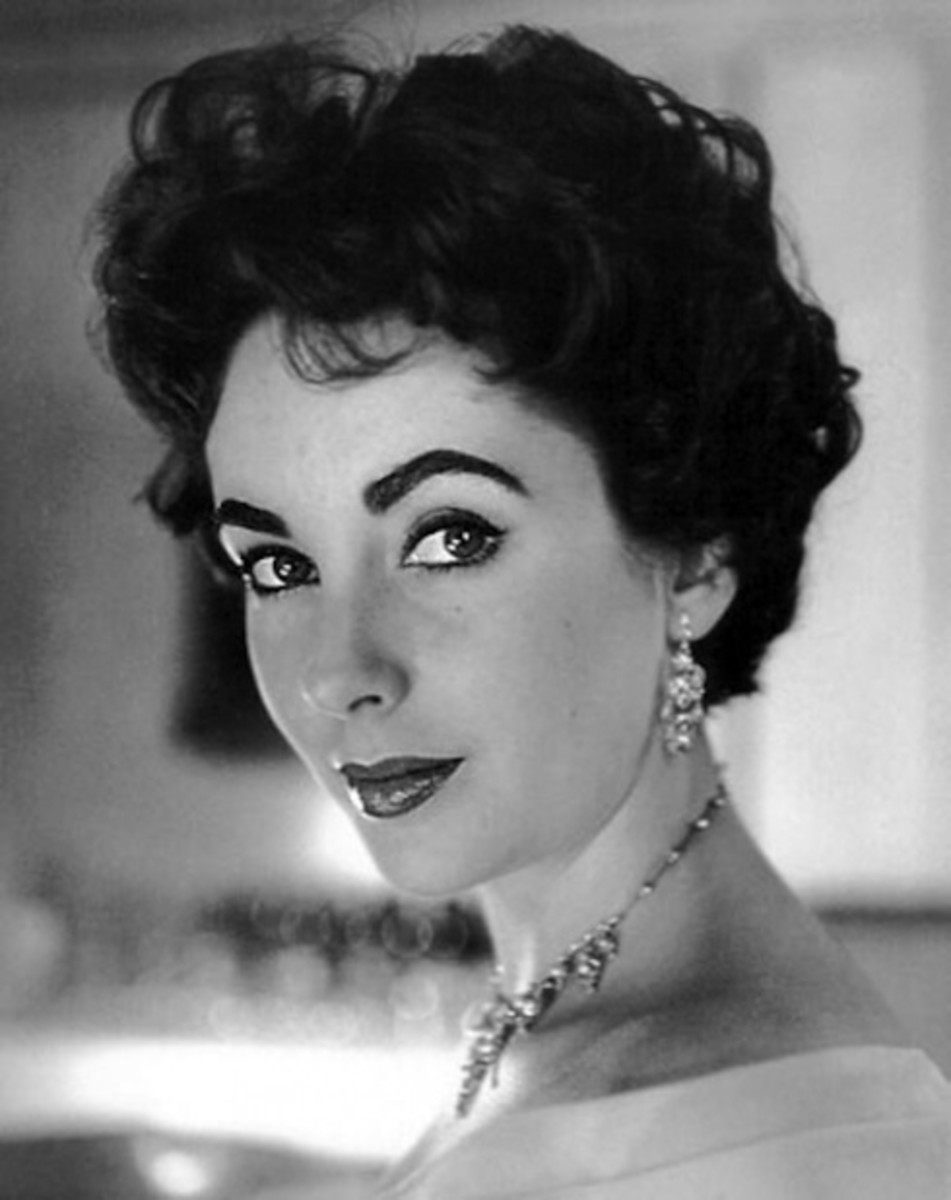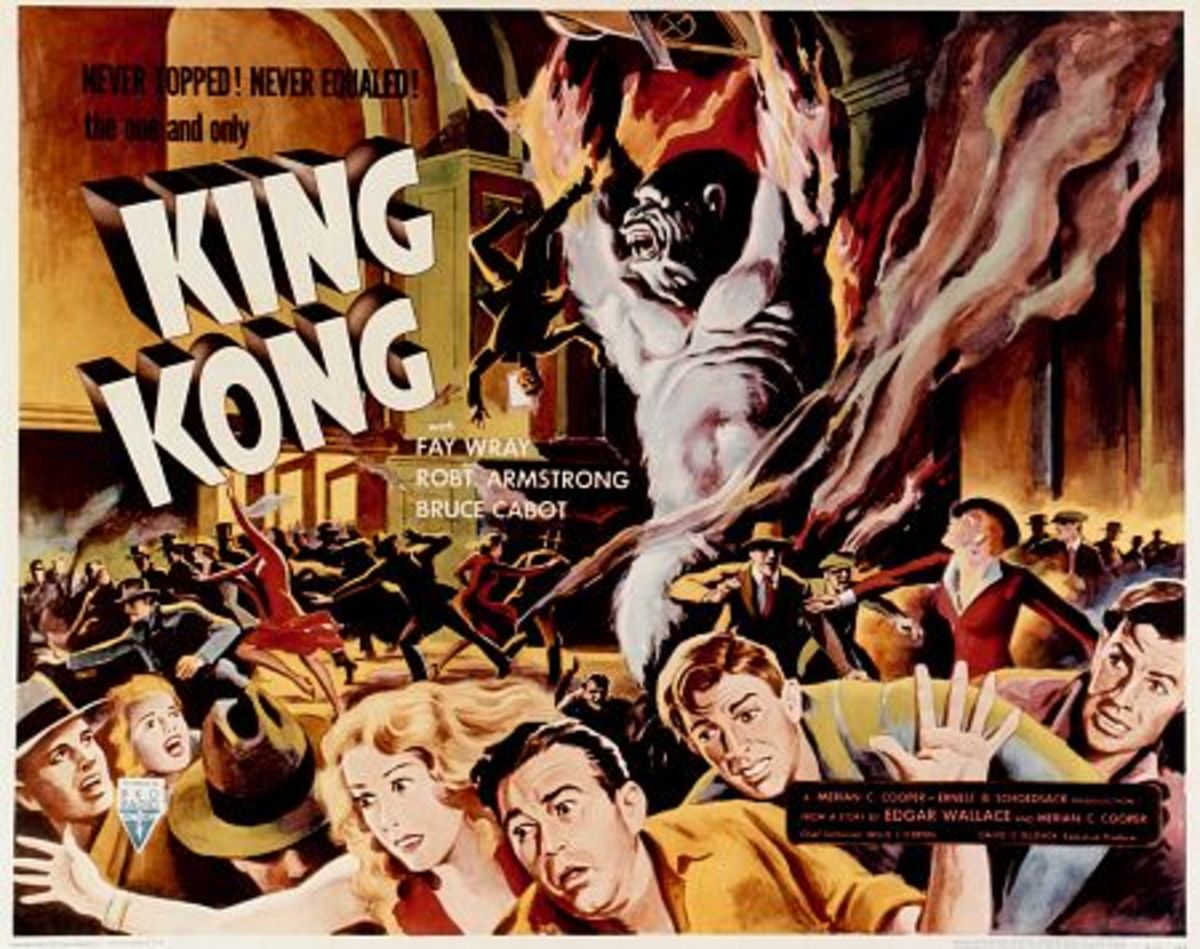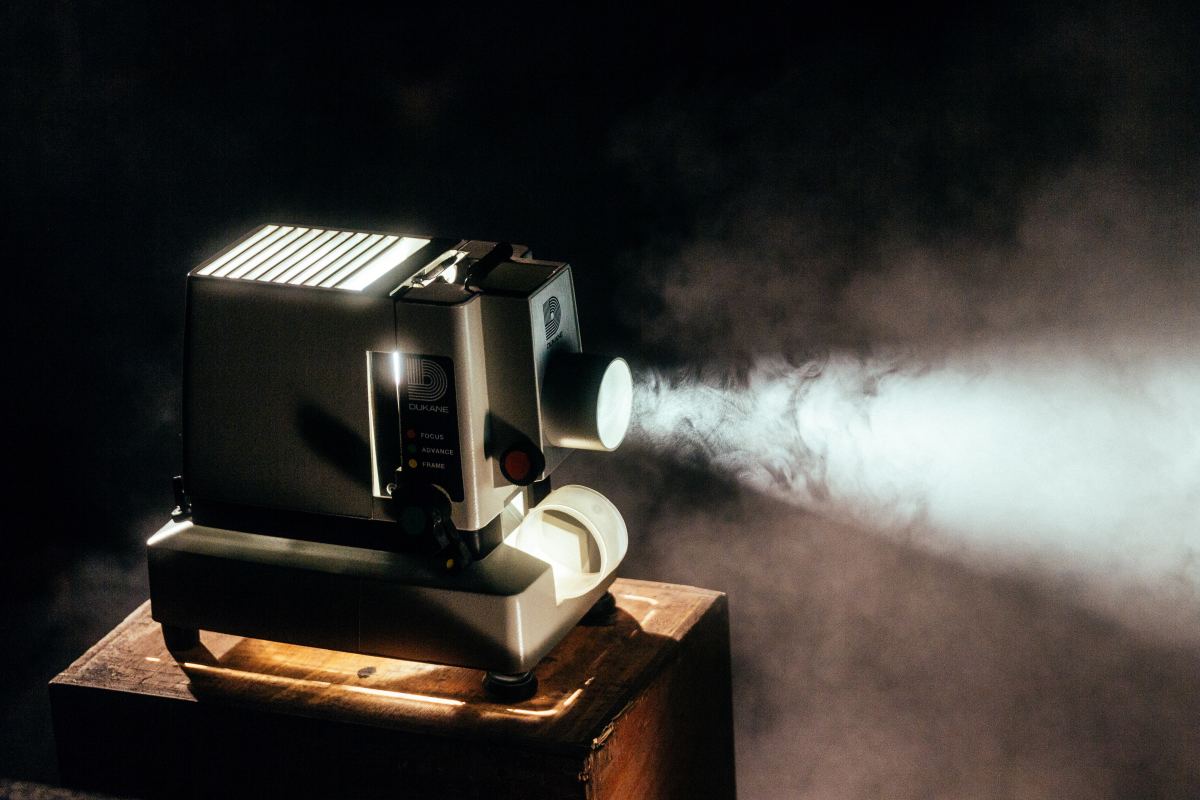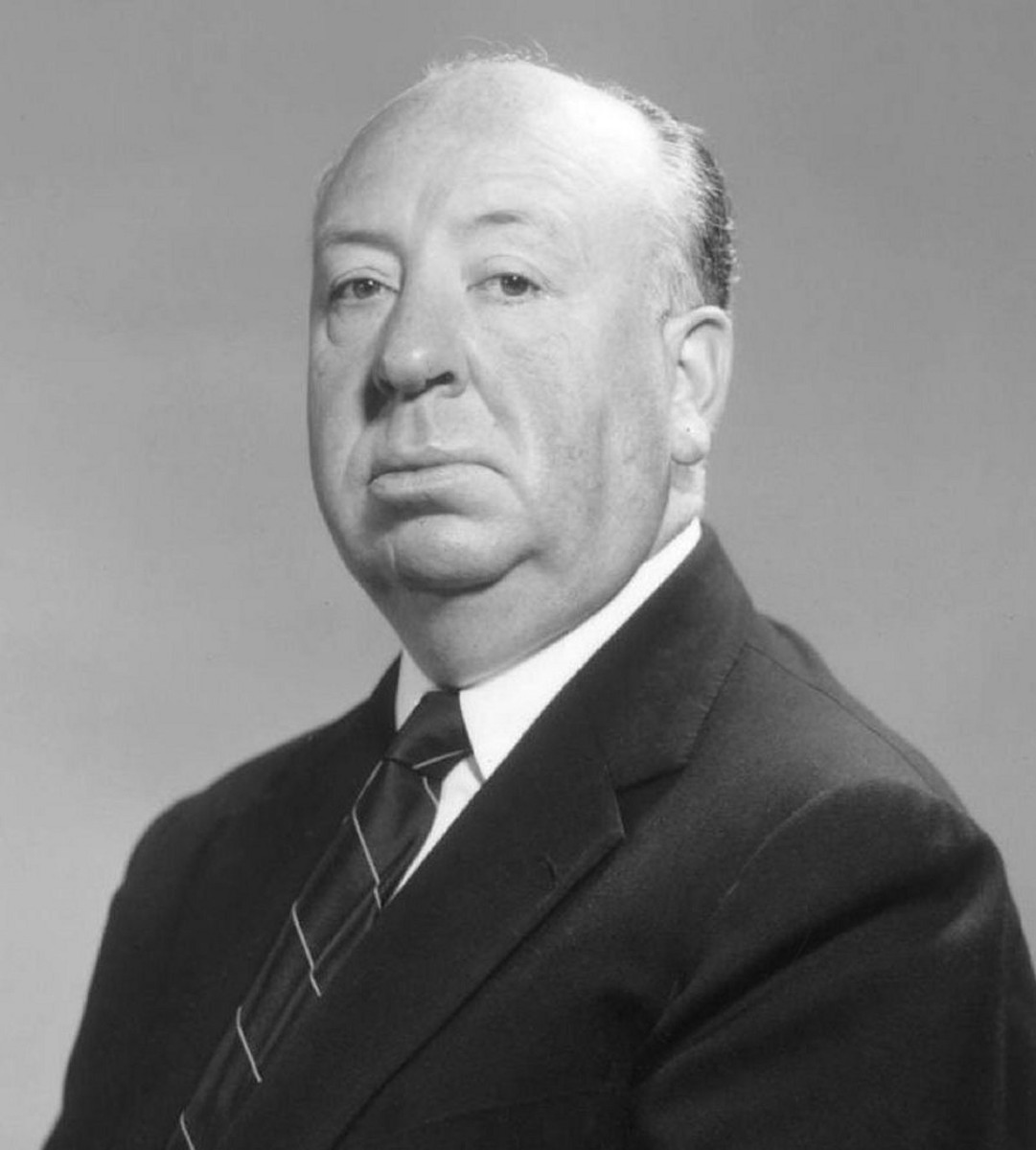The Summer of Kong
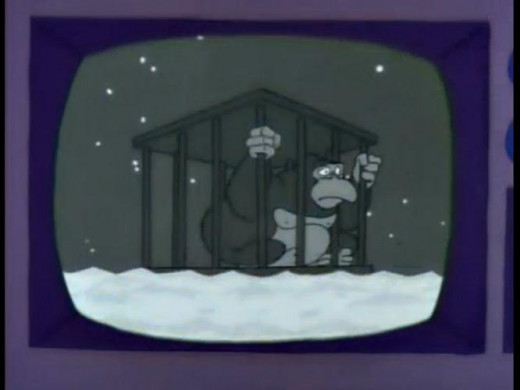
1976 was the year after Jaws and the year before Star Wars. It was also the year of King Kong, with Paramount releasing a remake of the classic. And in the weeks before the new King Kong movie was released, the talk among my friends was that someone made a movie where King Kong fights Jaws. None of us had actually seen the movie, but some of us had seen the poster, and perhaps the trailer. In fact, we were all too young for our parents to have allowed us to see Jaws. They thought it was too bloody and gory and would keep us up for weeks with nightmares. We could only imagine what Jaws was about. Now suddenly there was a movie being released in advance of Paramount's big budget King Kong remake that seemingly had the same ape fighting Jaws. And while none of us saw that movie either, it became the lunchroom talk for months.
A few years later when I was in High School, the topic of the Kong v Jaws movie was brought up again. This time with a new friend who was an expert in Asian monster movies. The movie, he said, was called A*P*E, and was a rip off of King Kong. It had been rushed into theaters to capitalize on the official King Kong remake. There was a shark battle in it, but only briefly. Even though it was not the King Kong vs Jaws movie I had been hoping for, A*P*E became a movie I was very curious of. I wanted to see it, but as far as I knew it was never on television, and home video was still a few years away. Gradually I forgot A*P*E even existed. That is until earlier this year. I was watching the episode of The Simpsons where Bart and Homer watch a ( fictitious ) film called Gorilla the Conqueror. Homer said it was "Giant Ape Week" on the Million Dollar Movie, suggesting that there were enough King Kong knock-offs that their local station could air five nights of giant ape films. I was contemplating if there actually existed enough Kong rip offs to fill an entire week of movies when, for the first time in decades, I thought of the movie A*P*E. Out of curiosity, I looked it up on Amazon, just to see if it ever got a home video release. I found a seller getting rid of the DVD for a penny. I thought I may as well buy the film for that cheap a price.
Right then and there I came up with two ideas. One, to write an article about all the King Kong rip off films that had been made over the years. Second, if I was to write an article then I would need to see the films I was writing about. This lead to the idea of purchasing every giant gorilla movie ever made, and having some sort of marathon. That idea was amended to watching one movie every Saturday afternoon, during the hours I usually watched a martial arts film ( Out of tradition. But that's another story. ) After a lot of research, I was able to come up with a list of every Kong movie, both legitimate and knock-off. It turned out there were not that many. Not as much as The Simpsons would suggest. But enough to fill out a summer. More on that marathon a little later.
A HISTORY OF GIANT APE MOVIES

King Kong was released by RKO Radio Pictures in 1933. It was the brain child of producer/director Merian C Cooper, and was partially based on real life events. There had been rumors of real life dragons existing in Komodo. In 1926 an expedition was lead to the Indonesian island to prove the dragon existed, and if possible, to capture and bring back live specimens. The Komodo Dragon was anything but. While it was an unusually large reptile, it had no wings, no serpentine body, no lion shaped head, nor any of the other physical attributes of the dragons of legend. But that did not stop explorers from bringing back two live dragons for the Bronx Zoo. The dragons were a sensation, but could not take the colder weather. Both would be dead within two months. Cooper himself was an explorer, having shot many movies that were half travelogue and half fiction using local actors. Cooper could imagine himself doing something as foolhardy as capturing and bringing back dragons, only to have them die in captivity. He began to visualize a tale where he traveled with a film crew to a prehistoric island, and ended up returning with a large animal. Only in his story the large animal was an ape.
King Kong would probably never have been made if not for a convergence of events. Five years earlier a film adaptation was made of Sir Arthur Conan Doyle's The Lost World, a novel where explorers discover a jungle in South America where the dinosaurs have not yet become extinct. In the book, the explorers bring back a pterodactyl as proof of their expedition, and on arrival to London it escapes and files away. Hollywood wanted a more exciting ending, so the movie adaptation had them bring back a brontosaurus which escapes and causes destruction. In order to depict a giant dinosaur demolishing buildings and chasing crowds, the studio turned to special effects genius Willis O'Brien who had perfected a new process called stop motion animation. Doyle was so impressed with O'Brien's work that he brought test footage of two dinosaurs fighting to a meeting of The Society of American Magicians, telling them the footage was made by real explorers. Most of those who attended the event were convinced the film was real.
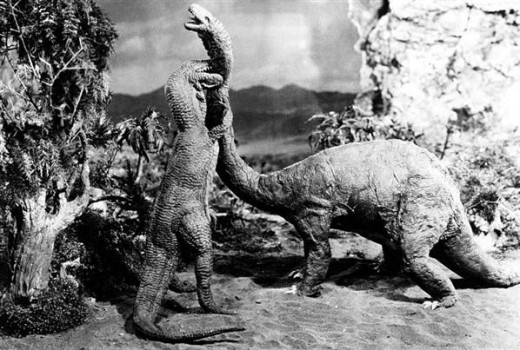
The Lost World was a hit, and O'Brien was eager to work on a sequel. He had ideas on improved visual effects where the actors could interact with the dinosaurs. But after a few false starts, the sequel never materialized. Finally O'Brien took his talents to RKO. And while they did not have the rights to Doyle's novel, they could easily make a knock-off. It was to be called Creation. But Creation turned out to be very complicated to stage and film. It had already cost RKO millions in pre-production with only 20 minutes of test footage to show for it. In 1933 a nearly bankrupt RKO hired Merian C Cooper as their new head of productions, and his first act was to cancel production on Creation before it cost the studio another cent. However, Cooper began to realize that the work done so far for Creation could easily be adapted for his giant ape movie. And they already had the jungle sets built for another production called The Most Dangerous Game. All Cooper needed to build was the native village and giant door set. So O'Brien's Creation morphed into King Kong, and he began work on a giant ape movie.
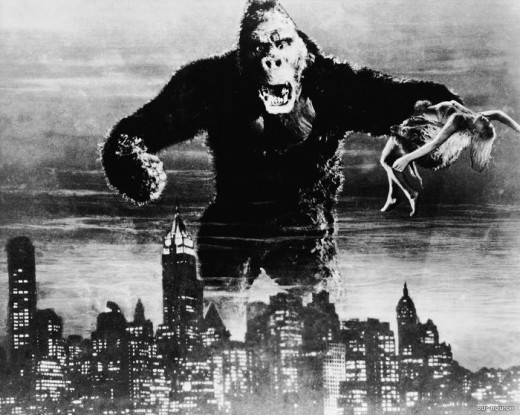
King Kong was a huge hit. RKO asked Cooper to rush out a sequel, and in six months Son of Kong was completed. RKO could probably have turned Kong into a franchise the same way Universal had done with Frankenstein and their other monsters. But there was a disagreement over who owned the character that arose when Cooper began work on a film for Pioneer Pictures that would have had King Kong fighting Tarzan. RKO put the kibosh on the new King Kong film, while Cooper reminded them that Kong was his creation. In the end they agreed Kong was co-owned by both Cooper and RKO, and no Kong picture would be made unless both sides worked together. But with Cooper moving on to other studios, this did not seem very likely. The closest RKO came to a new Kong sequel was in 1949 when they distributed Mighty Joe Young for Argosy Pictures, a stop motion animated film about a large friendly gorilla made by Cooper and the rest of the team that had worked on the original Kong films.
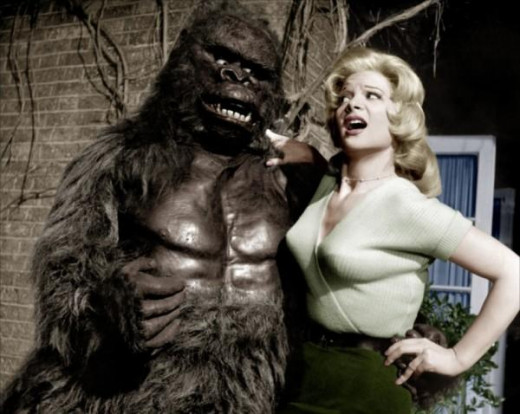
While the door was open for other studios to make their own ape films, none of them were interested in paying for the effects of a giant ape. Instead, the ape films that followed had normal sized apes using normal sized actors in gorilla costumes. Then in 1961 Anglo-Amalgamated Productions, the British movie studio responsible for the Carry On film series, decided to make the first giant ape film since Son of Kong. They would save money by doing away with stop motion animation, and film a normal sized actor in a gorilla costume, but using optical effects and a few miniature sets to make the gorilla look large. The ape would be called Konga, and the film would possibly lead to a franchise. After merchandising deals were made spinning Konga off into a series of Comic Books, Anglo-Amalgamated's lawyers convinced them they needed to pay RKO off for the right to do a film about a giant ape that had a very similar name to Kong.
Once it became known that RKO was willing to sell the movie rights, King Kong's original animator Willis O'Brien approached RKO for the rights so he could make his own King Kong sequel called King Kong Meets Frankenstein. The movie would have the Frankenstein Monster growing into a giant, then fighting King Kong in the ultimate monster fight. Producer John Beck was brought onto the project who was tasked with finding a studio who wanted the King Kong sequel. There had been a mid 50s movie craze for giant monster films which included Them! ( 1954 ), but by 1960 that craze had faded. Beck was unable find any studios interested in paying for O'Brien's stop-motion effects.However, in Japan, the giant monster craze was stronger than ever. Toho Studios took interest in the film, and bought the rights from Beck, cutting O'Brien out of the project. Although Toho had always wanted to produce their own Frankenstein film ( and would do so five years later with Frankenstein Conquers The World ( 1965 ) ) they ultimately decided to replace him with their own monster Godzilla. And thus, King Kong vs Godzilla ( 1962 ) was made.
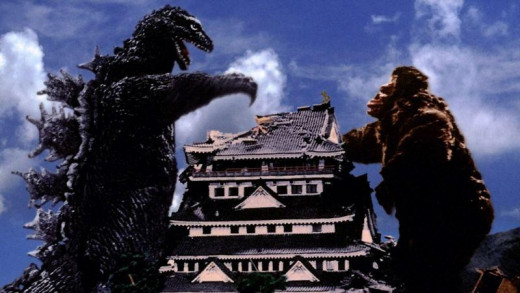
By now Cooper was aware that RKO was selling the film rights to King Kong, and began filing lawsuits to stop them. But not before Rankin/Bass acquired the rights with which they co-produced an animated King Kong series with Toei Studios. Toho was eager to make another King Kong movie, and negotiated with Rankin/Bass to co-produce King Kong Escapes ( 1967 ). But eventually further Kong movies would cease as Cooper and RKO went to court over the rights. By now televised broadcasts of the original King Kong movie, as well as the Toho films, had generated new interest in Kong. This resulted in one foreign exploitation movie being released under the erroneous American title Kong Island ( 1968 ), despite having no giant apes. And in one very low budget King Kong knock-off called The Mighty Gorga ( 1969 )
The real golden age for King Kong knock-offs would be 1976-77. The trigger was producer Dino De Laurentiis who paid RKO $200,000 for the rights to remake King Kong and Son of Kong. With a big budget Hollywood remake about to hit theaters, some foreign studios saw an advantage to releasing their own giant monkey films. The Lee Ming Film Co. of South Korea co-produced with America's Worldwide Entertainment Corp what amounted to an English language sequel to De Laurentiis' King Kong ( 1976 ) called The Great Counter Attack of King Kong ( 1976 ). The plan was to release the movie as a sequel shortly after King Kong ( 1976 ) was released in theaters. RKO threatened a lawsuit, and Worldwide Entertainment quickly had the name of the film changed to A*P*E. As long as they did not specifically identify the ape as Kong, there was not much RKO could do legally. A studio that did get sued was Dexter Films of Britain. They filmed a parody called Queen Kong ( 1976 ) and were promptly sued by De Laurentiis. Because of the lawsuit, the movie was never released in the U.K., although it did manage to get released in Italy and Germany, and once the lawsuit was long settled, began getting a home video release. The third knock-off, The Mighty Peking Man ( 1979 ), came from China's premier movie studio, Shaw Brothers.
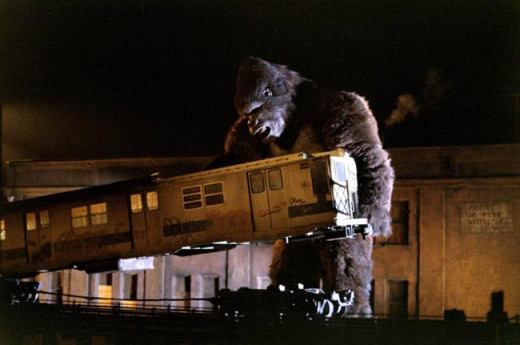
The second thing that De Laurentiis's remake of King Kong triggered was a slew of lawsuits. Ever since 1962 their had been two studios who desperately wanted King Kong as their own franchise, and RKO was not one of them. The success of the original King Kong in 1933 saved RKO from bankruptcy, and it would continue to produce many major motion picture classics in the years to come, including Citizen Kane in 1941, which has since been hailed as the greatest American film ever made. Troubles began when the studio was purchased by Howard Hughes, who's management style crippled the studio, and would green light such projects as John Wayne's The Conqueror ( 1956 ) which has since been considered one of the top ten worst movies ever made. The studio was sold to The General Tire and Rubber Company in 1955, who hired producer William Dozier as the new studio head. Dozier had little choice but to complete production on the movies Hughes left behind, and was not given much time by General Tire to turn the studio around. In 1957 General Tire announced RKO was ceasing movie production, and began selling off it's assets. The studio facilities were sold to Desilu, the production company owned by Lucille Ball and Desi Arnaz, who used the studio to film their own television series, as well as produce other television series ( including Star Trek. ) Desilu was eventually sold to Gulf+Western, who merged it with Paramount.
While General Tire had sold of RKO's studio and distribution company, they shrewdly retained the film library as the company RKO General. This not only allowed them to license their films for television broadcast, but to license the rights to their films for remakes and future sequels. It would not be until 1981 that RKO General would begin co-producing new movies with other studios. RKO had King Kong, which they profited from through it's television broadcasts, but no longer had the ability to produce any new King Kong films. They did think they could license Kong to other producers, which is what they did with John Beck for his proposed Willis O'Brien sequel. Beck in turn sold the rights to Toho, and Toho in turn partnered with Universal Pictures. Universal was one of the studios that passed on Willis O'Brien's proposed stop-motion animated movie, but then became interested in the franchise once Toho proved that the cheaper process of filming actors in costumes smashing miniature sets was just as profitable. Universal took the Japanese film, trimmed a few scenes, added some new footage with American actors as news reporters, did their own dubbing, and replaced the original music score with music from their own library. The American version of King Kong vs. Godzilla is very much a Universal production. With it's success both Toho and Universal desperately wanted to produce and release more King Kong films. They got a second chance with King Kong Escapes. Toho got to produce a second King Kong film. While this time Universal was not given the opportunity to recut the American version, they did get to be it's distributor.
Toho had made many attempts to regain the King Kong rights, but was never able to arrive at a deal with RKO. A sequel to King Kong vs Godzilla was twice attempted, the first time within a year of the original, and once again in the 90s. An attempt to make a King Kong solo movie in the 60s was aborted when Toho was unable to acquire the rights. The movie was made anyway, replacing King Kong with Godzilla. Unable to get Kong for any more films, Toho turned to Godzilla, who would go on to have a very successful film franchise of his own. Had Toho been able to negotiate a deal with RKO allowing them a King Kong franchise, it is very likely Godzilla would have been forgotten after only three films. Instead, Toho changed Godzilla from a villain to the hero, and the rest was motion picture history. In 1967 Toho once again tried acquire the licensing for Kong for their planned giant monster mash-up Destroy All Monsters ( 1968 ) but once again failed.
Part of the problem was that Universal was now making counter offers to license Kong for their own movie franchise. In the early 70s they arrived at some sort of verbal agreement with RKO General and began plans on their own King Kong film. That was until Dino De Laurentiis forked over nearly a quarter million dollars for the rights to his remake. Universal sued De Laurentiis,the production company Paramount Pictures and RKO to stop production on the new Kong movie, and RKO countersued Universal. As it began to appear that Universal was about to have their case thrown out of court, one of their lawyers made a discovery. A year prior to releasing King Kong, RKO had commissioned a novelization of the film to drum up interest. The studio had never bothered to renew the copyright on the novel, and by the 70s it was in the public domain. Universal claimed they now had every right to make a King Kong movie based on the now public domain novelization. The judge agreed.
Meanwhile, the new round of lawsuits opened the door for the estate of Merman C Cooper to file their own lawsuit claiming ownership to Kong. This time the judge was willing to listen. After carefully weighing all the evidence, the judge ruled that Cooper did indeed own the rights to King Kong. RKO still retained the rights over the original film and Son of Kong, allowing them to license the rights to remakes, and held that the novelization was still public domain, allowing Universal the right to make their own movie, provided it did not infringe on any copyrights of the previous films. In other words, they could make a King Kong movie as long as it was limited to the story from the novel, and looked nothing like the Kongs from any previous King Kong film. Not wanting a rival King Kong movie released, Paramount Pictures made a deal with Universal to hold of on production of their own King Kong movie for at least 18 months after their version of King Kong was released. In return Universal was given a cut of the new King Kong movie's profits.
In the meantime, Universal began negotiating with the Cooper estate, and bought the rights to King Kong, now making the character the property of Universal. This had a chilling effect on any studio attempting to produce any more King Kong knock-offs. It was one thing to get away with infringing on the King Kong copyright when the ownership of the character was still unresolved. But now the characters, basic plot and name "King Kong" were owned by Universal. The same Universal that was quick to sue any studio attempting to make their own Frankenstein or Dracula films.
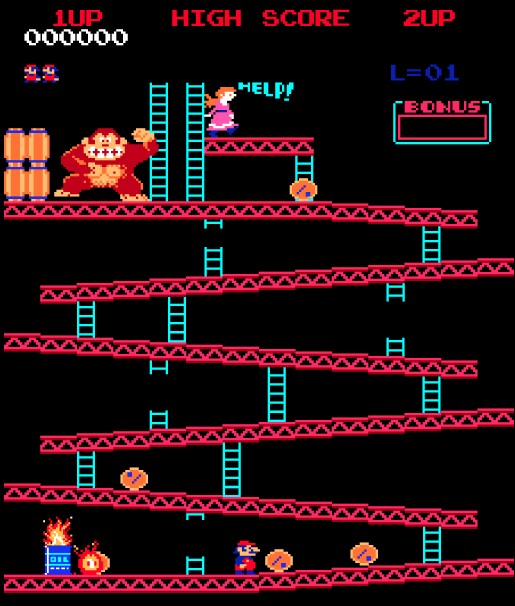
This fear seemed to be justified when Universal sued Nintendo in 1982 for infringing on the King Kong copyright. Nintendo had released a successful arcade video game called Donkey Kong, where the player controlled a character called Mario, who made his way trough obstacles in a construction site in order to rescue his girlfriend from a large ape. Universal claimed the name "Donkey Kong" was an infringement on the name "King Kong", and the plot of an ape kidnapping a girl and carrying her to the top of a building was an infringement on the King Kong plot. Nintendo countered that Universal had already argued and proven in court that King Kong and it's plot were in the public domain, and besides, Donkey Kong was protected as a parody. The court agreed, and even ruled that a hand held King Kong game Universal released through Tiger Games was an infringement on the Donkey Kong game.
But it was not just fear of the wrath of Universal that brought an end to the King Kong knock-offs. The giant monster craze in Japan had finally subsided. The Terror of Mechagodzilla ( 1975 ) was the first movie in the Godzilla franchise not to earn $1 million at the box office, and soon after the series was put on a hold that would last ten years. Japan was no longer seen as a territory to make back the money spent producing a giant monster film. There was hope that the 1976 remake of King Kong would spur new interest in giant monsters, specifically in the United States. But while King Kong '76 did make a hefty profit, it made nowhere the money that Jaws had a year earlier. The new fascination was with killer animals, and plenty of gore. The ironic thing was that as successful as Jaws was for Universal, it was the one property they could not defend. Great white sharks exist in nature, and therefore are public domain. Universal could not stop any studio from making their own shark movies. Nor could they stop them from using the word "jaws" in the title. De Laurentiis himself abandoned plans for the remake of Son of Kong and instead did his own version of Jaws called Orca ( 1977 ) featuring a killer whale.
Universal, who had fought in court for the right to do their own remake of King Kong, and had paid the Cooper estate a small fortune to obtain exclusive rights to the character, was suddenly no longer interested in making a King Kong movie. They had already begun pre-production on a King Kong remake after getting the judgment that the novel was public domain, but had made a further agreement with Paramount to hold off on their version in trade of some of the profits from the '76 remake. But by 1977 Universal had no Kong movie in production, and instead was busy with the production of Jaws II.
By the mid 80s, De Laurentiis was faced with having his rights for a remake of Son of Kong expire. Deciding to use those rights instead of losing them, he commissioned the film. John Guillerman was brought back to direct, but there was no chance of getting any of the original cast to agree to be in the sequel. The Son of Kong remake only kept one element from the original, the fact that Kong had a son. Despite having Kong fatally shot, and falling from the roof of what was then the world's tallest building, De Laurentiis insisted that Kong would be in the sequel. Since 1976 he had a story outline where scientists bring Kong back to life, which was part of each script ever since. In King Kong Lives ( 1986 ) Kong has been in a coma for more than a decade, and can only be revived if he gets an artificial heart. But the operation can not take place because no one had giant ape blood. That is until a giant female ape is captured in Borneo. The operation is a success. Kong comes out of his comma, and almost immediately escapes. He rescues the female ape from her captors, and together they run off to the mountains.While it seemed like bringing Kong back to life and giving him a proper mate to fall in love with was a good idea for a sequel, most critics disagreed. King Kong Lives was universally panned as one of the worst monster movies ever made, and was a failure at the box office.
It would be nearly 30 years before Universal actually made their own King Kong movie. In the meantime, Warner Bros. decided to adapt the public domain novel into a Disney style cartoon musical. No other studio seemed interested in making a Kong movie, even though the novel was up for grabs. Part of the problem was that both stop motion animation and actors in gorilla costumes smashing models of buildings had dated. Audiences wanted state of the art visual effects. And that gets expensive. As it was expensive for Disney when they decided to co-produce a remake of Mighty Joe Young with RKO Pictures. Extremely expensive visual effects brought the ape to life. And then the film bombed, losing Disney and RKO $40 million for it's initial run. While they would eventually make up the difference and turn a hefty profit in the overseas and home video market, Mighty Joe Young was seen as a box office bomb. As far as Hollywood was concerned, Americans were no longer interested in giant apes.
But that did not stop television producers from acquiring the rights for a Saturday morning cartoon series. Kong: The Animated Series was produced in 2000 for a 40 episode 2 season run. It's convoluted plot was a continuation of the 1933 King Kong movie. A female scientist acquired a sample of King Kong's DNA shortly after his demise, and spent the next 67 years attempting to clone him. She eventually combined Kong's DNA with DNA from her infant grandson, and both her grandson and Kong clone grew up as brothers back on Skull Island. It was a decent enough animated series, but had little chance of being a mainstream success. It was part of the BKN Cartoon Network, a syndicated block of afternoon cartoons which came out about the same time FOX, UPN and the WB Networks had their own afternoon blocks of original cartoons. This left very few stations across the country who had the air time available for more cartoons. When BKN shut down productions, reruns of the Kong series was sold to FOX for it's afternoon block. This gained the series enough popularity for two direct to video movies to be produced, but Kong: The Animated Series would go no further than having a cult following, and do nothing to re-ignite interest in King Kong.
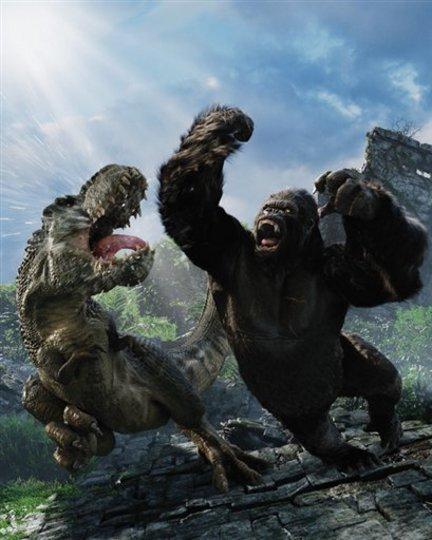
There was, however, one film maker determined to make a new Kong film. The original 1933 King Kong was the favorite film of director Peter Jackson since he saw it as a child in 1970. In 1995 Jackson was filming The Frighteners for Universal. The studio was so impressed with the unreleased film that they sought to have him film another horror movie for their studio. Jackson turned down the projects Universal offered, including a remake of Creature from the Black Lagoon. But then someone at Universal found out that he was a huge fan of King Kong, a monster they just happened to own. The Frighteners ( 1996 ) was not the huge hit Universal was hoping for, just barely breaking even at the box office. But by that time Universal had new reasons to want a King Kong remake. One was Disney's remake of Mighty Joe Young, the other was Tri-Star's American remake of Godzilla. There seemed to be renewed interest in giant monsters, and Universal wanted to be part of it. When Godzilla became a critical flop, and Disney's Mighty Joe Young a box office flop, Universal finally pulled the plug on the King Kong remake.
But Jackson had spent three years in pre production, and was not yet wiling to give up. When The Lord of the Rings trilogy became a huge success, Universal wanted to work with Jackson again. Jackson was willing to make another film for the studio, on condition that movie be the King Kong he had worked on years earlier. Jackson's remake of King Kong was released in 2005, and was both a financial and critical success. Enough that Universal would think of finally turning King Kong into a franchise. But predictably, it took them nearly a decade to agree on a project. If all goes well, Kong: Skull Island should be released in 2017. Initially planned as a prequel to the Jackson ( and/or Cooper ) movie, word is that it will have a brand new time line, possibly taking place in the 70s.
Should Kong: Skull Island get released, and become a box office hit, a proper King Kong franchise is bound to follow. And perhaps this time there will be less than a decade between films. As for any Kong knock-offs, Asylum has been the only studio to attempt one since Shaw Brothers Goliathon in 1977. Asylum produces ultra low budget direct-to-video movies, most specifically designed to be knock-offs of current hit films in the science fiction, fantasy and horror genres. The studio's profile rose in the past few years when it began producing films for the SyFy Channel, including the infamous Sharknado franchise. King of the Lost World ( 2005 ) is described as a mash up of Sir Arthur Conan Doyle's now public domain novel The Lost World, and the television series Lost. But with Peter Jackson's King Kong in the theaters, Asylum decided to throw a giant gorilla of their own in the movie.
Steps had been taken to make sure the giant ape did not violate Universal's rights to the King Kong character. But just in case, Asylum reportedly shot the movie in a way that the giant ape could be edited out of the film and not effect the story. It is the risk of a lawsuit that has kept many studios from making any more giant gorilla movies. Even with the ruling in the Universal v Nintendo lawsuit that confirms the King Kong story is in the public domain, many producers can still remember how distribution of Queen Kong had been blocked. And that was when it was still unsettled as to who actually owned the rights to Kong. Even the fact that Queen Kong was a parody did not protect it against a lawsuit. And even if a lawsuit could eventually be thrown out, temporarily blocking distribution is enough to lose profits for the film. The makers of the parody film Date Movie ( 2006 ) wanted to include a brief parody of King Kong. While they did not hesitate including parodies of everything from Meet the Fockers to The Wedding Crashers, the one movie Regency lawyers were lost sleep over was the King Kong parody, to the point where they reportedly insisted it came at the end of the film where it could easily be edited out, and even reportedly refused to allow outtakes and deleted scenes from the Kong sequence on the DVD.
It is a very unusual situation that keeps giant gorilla movies from being produced. If you make a knock-off of King Kong you could be sued for copyright infringement by Universal, even if your movie is a confirmed parody. But in an ironic legal loophole, you can legally make a movie that is a direct remake of the original King Kong movie, using the exact same plot and all of the same characters, even call it King Kong, and not violate any copyrights. There is a catch though. Even your remake could end up in court. While the original King Kong story is now in the public domain, the various studios that made Kong movies in the past could still sue for infringement on elements from their films. For example, if your ape looks anything like the stop motion animated puppet used in the original, then ROOK could sue. And if your Kong costume looks anything like one of the OTOH costumes then they could sue. These sort of petty lawsuits have plagued Hollywood productions for decades. Universal should know. When they produced the television series Battles Galactic in the ass, Lucas Films and 20th Century Fox sued claiming infringement of elements from Star Wars. Universal countersued claiming Star Wars infringed on elements from the Buck Rogers and Flash Gordon serials they had made back in the 30s.
But the biggest thing keeping Kong films from being made is the production cost. Almost all the knock-offs were made using actors in gorilla suits smashing models of buildings in miniature cities. Those sort of special effects are no longer acceptable to today's audiences. Today's monster movies require expensive CGI effects, well out of the range of most independent producers. Even for the major studios, producing a remake of King Kong is risky. As a public domain property, there is nothing preventing any rival studios from producing their own Kong film and releasing it the same year.
THE MARATHON
Now that we are up to date with the history of the Kong and imitation Kong films, it is time to begin my four month marathon. Each Saturday at three I will be watching one of the films, or if something comes up, watching them later on at night. If all goes as scheduled, I will be ending the marathon on Saturday September 5th during Labor Day Weekend. In order to do that, the marathon must begin the second week of May. I will be taking a break for the July 4th weekend as I may have to bail that day for family activities. But as I probably will be given the Friday or following Monday off, I am currently thinking of using that weekend to watch as many of the "odds and ends" as I can get to. These are the movies that are related to King Kong but do not have a giant ape, have King Kong in a brief cameo, or have Kong or another giant ape but don't really qualify as a movie. Even though it is a week before the marathon is set to begin, I decided to spend this Saturday re-watching The Lost World ( 1925 ), the classic silent thriller about explorers who discover an Amazon jungle with living dinosaurs. It was not a direct predecessor to King Kong as many claim, but the idea of a dinosaur filled jungle did eventually become an important plot point in the later film. And it is also doubtful that King Kong would have been made if this film had not been made first. It clearly does belong in the odds and ends weekend, but since it predates King Kong I felt I needed to screen it a week before I watched the original King Kong. And besides, I already have too much to watch during the July 4th weekend, and need to lighten the load.
That last paragraph was was written four days ago. I have just finished watching The Lost World. I have actually seen this film a few times before, and own it both on laserdisc, and a DVD that was purchased after several minutes of footage was rediscovered and edited back into the movie. As it stands now, The Lost World is still incomplete. The full version screened back in the 1920s. But shortly after, the film was cut down for it's re-releases. While the DVD is the most complete version of the movie released on home video to date, there has not yet been a complete restoration, and it is likely some of the missing footage will never be located. However, even the truncated version of The Lost World is fun to watch. One of my favorite films from the silent era at any length. And it was perfect for putting me in the mood for seeing King Kong, a movie which, for whatever reason, I have not seen at all since the 80s, and perhaps even as far back as the 70s.
I began this article including the research in mid April. I am finishing this section on May 2, 2015. Since the article turned out longer than planned, I have decided to break it up into two parts. Part two will be the marathon. I will write my opinion of each film the day I watch it. Sort of like a diary of my marathon.



